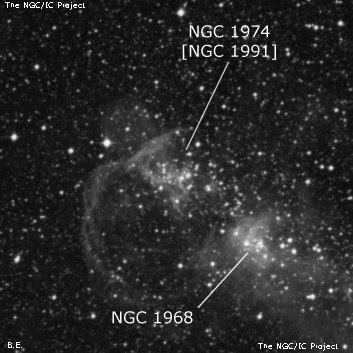NGC/IC Project Restoration Effort
(This is a very very beta version)
NGC1974


Basic Information
Location and Magnitude
Right Ascension: 5:28:0.4
Declination: -67:25:23
Constellation: DOR
Visual Magnitude: 9.0
Historic Information
Discoverer: Dunlop
Year of discovery: 1826
Discovery aperture: 9.0
Observational
Summary description: Cl, L, irr
Sub-type: OCL+EN
Corwin's Notes
=====
NGC 1974 = NGC 1991 is a stellar association in the northern part of the LMC.
JH calls it the fourth in a line of four (though he did not measure the first,
so that does not have an NGC number). He also made a one minute error in the
RA of NGC 1991. This was first caught, as far as I know, by Paul Hodge and is
noted in his and Francis Wright's LMC Atlas. The observation leading to N1974
is the only one in the field not from Sweep 760 on 2 Jan 1837.
The DSS image shows a field very much as JH describes it: "... a great line
of rich clusters which are connected by abundant scattered stars. (The first
not taken.)" The other NGC objects are NGC 1955 and NGC 1968. The western-
most, which JH did not measure, is at 05 25 32.4, -67 31 49 (B1950.0). All
are wreathed in loops and tangles of nebulosity, probably supernova remnants
and HII regions.
Curiously, all but the first of the associations appear to be double on the
DSS image. JH's positions fall in between these concentrations, so I've
estimated the centers of them, and have measured the approximate centers for
each concentration. It may be that there are no really separate clusters
here, just one large, extended, star-forming region.
Steve's Notes
=====
NGC 1974
30" (11/5/10 - Coonabarabran, 264x): fourth in a great looping chain of clusters and nebulosity (collectively called the "Sextant Arc") including NGC 1955 and NGC 1968 to the SW. This group is virtually attached to NGC 1968, only distinguished by less nebulosity and stars. There are roughly three dozen stars resolved in a 3' circular group (stellar association LH 63) including a number of mag 12-13 stars. The cluster is involved in fairly bright nebulous haze (LCM-N51A). NGC 1991 is a duplicate entry with a 1 minute error in RA.



